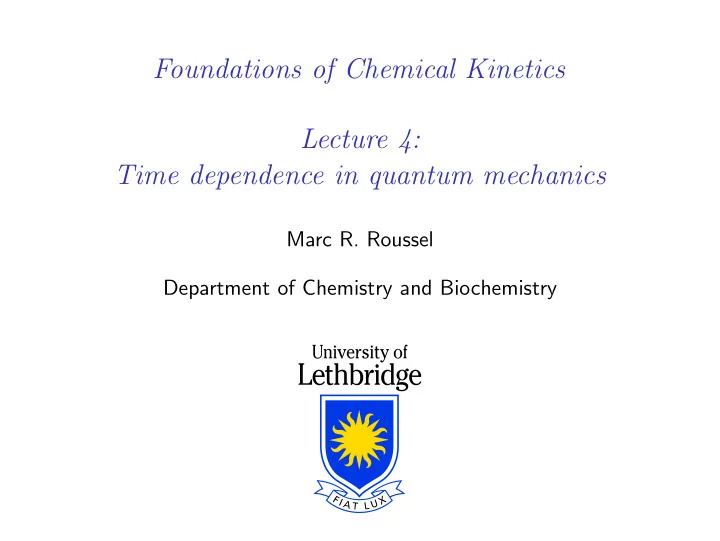

Foundations of Chemical Kinetics Lecture 4: Time dependence in quantum mechanics Marc R. Roussel Department of Chemistry and Biochemistry
Complex numbers Complex numbers are of the form a + ib where i has the property i 2 = − 1. Euler’s formula: e i θ = cos θ + i sin θ Complex conjugate: If z = a + ib , the complex conjugate of z is z ∗ = a − ib . Consequence: ( e i θ ) ∗ = e − i θ
The time-dependent Schr¨ odinger equation for a single particle in one dimension H Ψ( x , t ) = i � ∂ ˆ ∂ t Ψ( x , t )
Relationship between the time-dependent and time-independent equations H Ψ( x , t ) = i � ∂ ˆ ∂ t Ψ( x , t ) ◮ If ˆ H is independent of time, this equation is separable, i.e. Ψ( x , t ) = ψ ( x ) f ( t ) ◮ Substitute this form into the Schr¨ odinger equation: H [ ψ ( x ) f ( t )] = i � ∂ ˆ ∂ t [ ψ ( x ) f ( t )] H ψ ( x ) = i � ψ ( x ) df ( t ) ∴ f ( t )ˆ dt
Relationship between the time-dependent and time-independent equations (continued) f ( t ) ψ ( x ) df ( t ) ˆ H ψ ( x ) = i � ∴ ψ ( x ) f ( t ) ψ ( x ) f ( t ) dt 1 i � df ( t ) ˆ H ψ ( x ) = ∴ ψ ( x ) f ( t ) dt ◮ The left-hand side only depends on x , while the right-hand side only depends on t . This can only be the case if each side is equal to a constant. Call this constant E : 1 df ( t ) i � ˆ H ψ ( x ) = E = ψ ( x ) f ( t ) dt
Relationship between the time-dependent and time-independent equations (continued) ∴ ˆ H ψ ( x ) = E ψ ( x ) df ( t ) = E i � f ( t ) = − iE and � f ( t ) dt ◮ The first equation is just the time-independent equation.
Relationship between the time-dependent and time-independent equations (continued) ◮ The second equation is easily solved by separation of variables: df = − iE � dt f � df = − iE � dt ∴ f � ∴ ln f = − iE � t � � − iE or f = exp � t
Relationship between the time-dependent and time-independent equations (continued) ◮ Now putting the pieces back together, we get � − iE � Ψ( x , t ) = ψ ( x ) exp (1) � t ◮ For simplicity, define ω = E / � , so that Ψ( x , t ) = ψ ( x ) e − i ω t ◮ Note: Ψ ∗ Ψ = ψ ∗ ψ , i.e. the probability density is time-independent and identical to that obtained from the time-independent Schr¨ odinger equation. ◮ We call a separable solution like (1) a stationary solution.
Superposition solutions ◮ The time-dependent equation admits solutions that are constructed by superposition of stationary solutions. ◮ Suppose that Ψ 1 ( x , t ) = ψ 1 ( x ) e − i ω 1 t and Ψ 2 ( x , t ) = ψ 2 ( x ) e − i ω 2 t with ˆ H ψ i = E i ψ i , ω i = E i / � , and E 1 � = E 2 . Define Φ( x , t ) = Ψ 1 ( x , t ) + Ψ 2 ( x , t ). ◮ We will now substitute this trial solution into Schr¨ odinger’s equation and verify that it satisfies the equation.
Superposition solutions (continued) LHS RHS ˆ i � ∂ Φ H Φ ∂ t ψ 1 e − i ω 1 t + ψ 2 e − i ω 2 t � ψ 1 e − i ω 1 t + ψ 2 e − i ω 2 t � ˆ i � ∂ � � H ∂ t e − i ω 1 t ˆ H ψ 1 + e − i ω 2 t ˆ ∂ t e − i ω 1 t + i � ψ 2 ∂ i � ψ 1 ∂ ∂ t e − i ω 2 t H ψ 2 E 1 ψ 1 e − i ω 1 t + E 2 ψ 2 e − i ω 2 t − i 2 � ω 1 ψ 1 e − i ω 1 t − i 2 � ω 2 ψ 2 e − i ω 2 t E 1 ψ 1 e − i ω 1 t + E 2 ψ 2 e − i ω 2 t QED
Recommend
More recommend